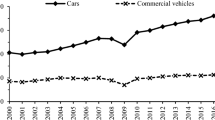Abstract
The fire dynamics simulator (FDS) is a program based on computational fluid dynamics (CFD) and is used extensively by fire research staff. Currently, it is used widely in various fields, including reconstruction simulations of fire scenes. Buses can be designed to carry many passengers, and in public places, incidents such as bus fires impose a relatively high threat to assets and lives. Hence, it is common to witness substantial casualties when a bus fire occurs. This paper investigates an incident that occurred on July 19, 2016 in Taiwan, where in a sightseeing tour bus caught fire on a highway, leading to the death of all 26 passengers on board. The investigation results show that the deaths were due to closed emergency exits and thick smoke and that the opening of emergency doors and the number of emergency exits significantly influence the success of evacuation. Furthermore, we analyze this case of vehicle fires installing an interior safety door, separating a bus into isolated categories or compartments helps in delaying the spread of fire. These results can provide some valuable information on risk evaluation and prevention of vehicle fires.













Similar content being viewed by others
References
McGrattan, K., Hostikka, S., McDermott, R., Floyd, J., Weinschenk, C., Overholt, K.: Fire Dynamics Simulator—User’s Guide. NIST Special Publ. 1019, Sixth Edition, USA (2013)
Chi, J.-H.: Using thermal analysis experiment and Fire Dynamics Simulator (FDS) to reconstruct an arson fire scene. J. Therm. Anal. Calorim. 113, 641–648 (2012)
Glasa, J., Valasek, L., Halada, L., Weisenpacher, P.: Modelling of impact of fire on safe people evacuation in tunnel. J. Phys: Conf. Ser. 490, 012067 (2014)
Hadjisophocleous, G., Jia, Q.: Comparison of FDS prediction of smoke movement in a 10-storey building with experimental data. Fire Technol. 45, 163–177 (2009)
Shen, T.-S., Huang, Y.-H., Chien, S.-W.: Using fire dynamic simulation (FDS) to reconstruct an arson fire scene. Build. Environ. 43, 1036–1045 (2008)
Yang, P., Yao, G., Tan, X.: Modeling carbon black trace in building fire and its validation. Tunn. Undergr. Space Technol. 49, 35–48 (2015)
Horváth, I., van Beeck, J., Merci, B.: Full-scale and reduced-scale tests on smoke movement in case of car park fire. Fire Saf. J. 57, 35–43 (2013)
Lemaire, T., Kenyon, Y.: Large scale fire tests in the second benelux tunnel. Fire Technol. 42, 329–350 (2006)
Li, J., Zhang, K., Guo, J., Jiang, K.: Reasons analyzing of school bus accidents in China. Proc. Eng. 45, 841–846 (2012)
Abulhassan, Y., Davis, J., Sesek, R., Gallagher, S., Schall, M.: Establishing school bus baseline emergency evacuation times for elementary school students. Saf. Sci. 89, 249–255 (2016)
Maputi, E.: Conceptual design of a bus emergency exit ramp. Int. J. Sci. Res. 3, 189–192 (2010)
Traina, N., Kerber, S., Kyritsis, D.C., Horn, G.P.: Occupant tenability in single family homes: part I—impact of structure type, fire location and interior doors prior to fire department arrival. Fire Technol. 53, 1589–1610 (2017)
Izydorczyk, D., Sędłak, B., Papis, B., Turkowski, P.: Doors with specific fire resistance class. Proc. Eng. 172, 417–525 (2017)
Traina, N., Kerber, S., Kyritsis, D.C., Horn, G.P.: Occupant tenability in single family homes: part I—Impact of Structure Type, fire location and interior doors prior to fire department arrival. Fire Technol. 53, 1589–1610 (2017)
Gianfranco Caruso, L.F.: Numerical simulation of a fire scenario. CFD Lett. 6, 131–143 (2014)
Korhonen, T.: Fire Dynamics Simulator with Evacuation: FDS + Evac, Technical Reference and User’s Guide; FDS 6.1.2, Evac 2.5.0 (2015)
Wagner, N., Agrawal, V.: An agent-based simulation system for concert venue crowd evacuation modeling in the presence of a fire disaster. Expert Syst. Appl. 41, 2807–2815 (2014)
Lo, S.M., Wang, W.L., Liu, S.B., Ma, J.: Using agent-based simulation model for studying fire escape process in metro stations. Proc. Comput. Sci. 32, 388–396 (2014)
Purser, D.A.: Toxicity assessment of combustion products. In: SFPE handbook of fire protection engineering, 3rd edn. National Fire Protection Association, Quincy, MA (2002)
Shock 26 dead in Taiwan tourist bus fire, Apple Daily, 2016.07.20
Haack, A.: Fire protection in traffic tunnels: general aspects and results of the EUREKA project. Tunn. Undergr. Space Technol. 13(4), 377–381 (1998)
Author information
Authors and Affiliations
Corresponding author
Rights and permissions
About this article
Cite this article
Lin, CS., Hsu, JP. Modeling and analysis of a bus fire accident for evaluation of fire safety door using the fire dynamics simulator. Cluster Comput 22 (Suppl 6), 14973–14981 (2019). https://doi.org/10.1007/s10586-018-2464-9
Received:
Revised:
Accepted:
Published:
Issue Date:
DOI: https://doi.org/10.1007/s10586-018-2464-9




